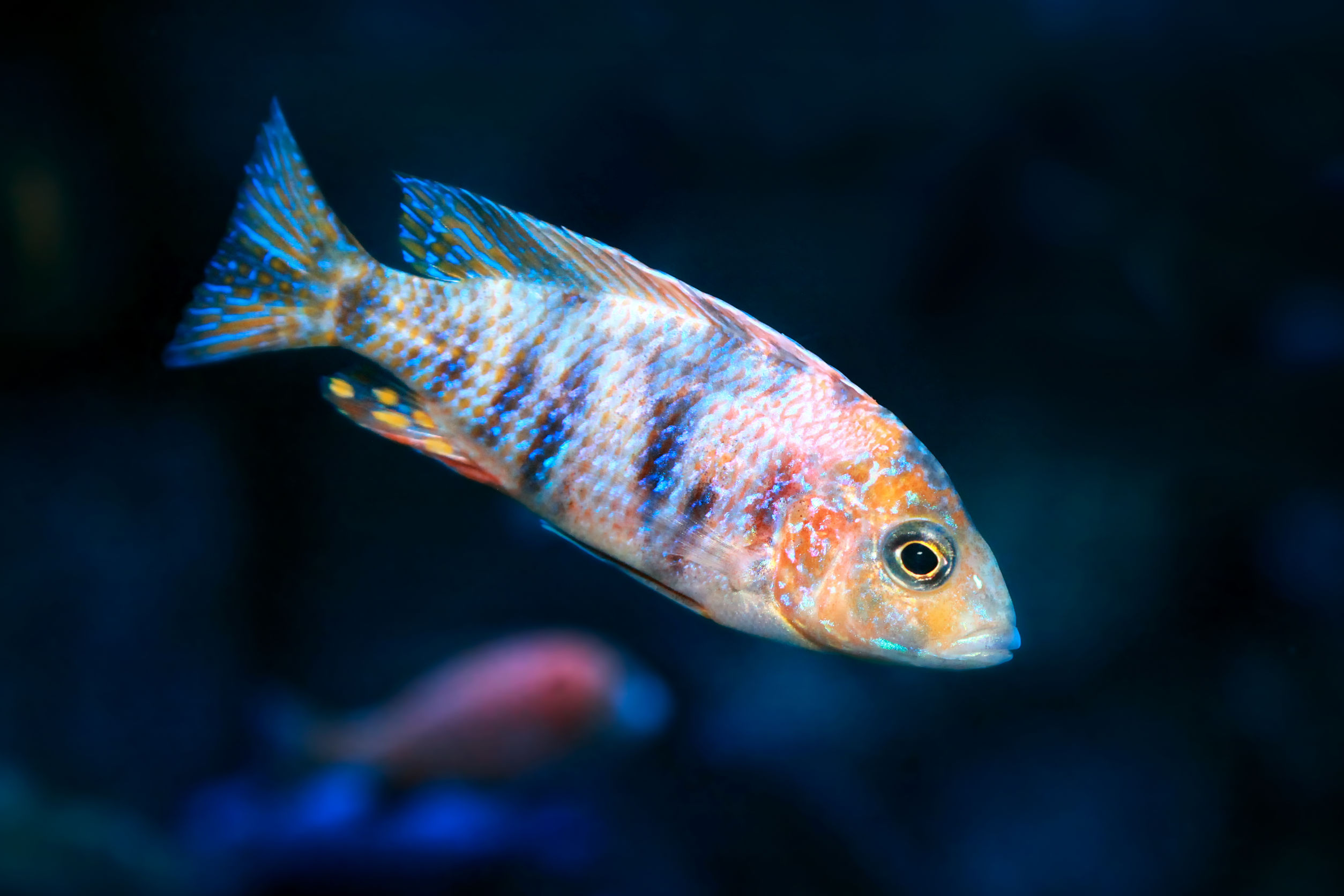When you purchase a fish, you generally expect it to stay the same color as when you bought it. Guppies and tetras come in a variety of colors and patterns, and don’t forget about mollies and platies! But if the fish you bought was a cichlid, you could see it change colors. That may or may not be a reason for concern.
What could cause a cichlid to change color?
- Poor Diet
- Stress
- Sickness
- Social Status
- Age
They generally should be the color they were when you purchased them at your local fish store—but there are a few reasons they might not stay as vibrant as when you first bought them. I’ll go more in-depth about my list and let you know which reasons are nothing to worry about, and when you should be concerned.
What Causes the Loss of Color in Cichlids?
Let’s start with the most troubling color issue for cichlids—color fading or loss of color. You bought that beauty with the bright yellow fins or pretty blue splotches, and now the color is hardly noticeable. What’s going on with your cichlids color? There could be several reasons this is happening, and I take a look at each one below in more detail.
1. Poor Diet
This is probably the easiest issue to correct. Your cichlids do best with a varied diet, which ensures they’re getting all the nutrients they need to be healthy and happy. While many cichlids will be fine with a flake or pellet food, most varieties are omnivores in the wild, meaning they’ll eat a little bit of everything—so try to mimic that in your feeding routine, too.
If you notice your cichlids’ colors fading, you may need to switch up their diet from time to time to include:
- Freeze-dried brine shrimp
- Bloodworms
- Algae wafers or pellets
- Live feeder fish (depending on your cichlid species)
You can also enhance the color of your cichlids by ensuring that their main pellet or flake food contains color enhancers, like carotenoids, to keep them looking bright.
2. Stress
Fish get stressed for a variety of reasons—but the good news is almost all of them are things you can control! The main culprits when it comes to causing stress in your fish are:
- Incompatible tank mates
- Having a tank that’s too small for the size or number of fish
- Poor water quality
- Not creating enough hiding spaces for your cichlids
Thankfully, most of these stressors are easy to correct! That being said, you may struggle to part with a beloved fish, or may not be able to purchase a new tank. Hopefully, I’ve given you enough options below to find one you and your fish can feel good about.
| Stressor | Solutions |
| Incompatible Tankmates |
|
| Too-small tank |
|
| Poor Water Quality |
|
| Too Few Hiding Places |
|
3. Sickness
If everything else is good in your tank, and your cichlids are normally happy, then fading colors could mean you have a sick fish on your hands. This could be something to worry about depending on the type of disease your cichlid has.
Nearly every fish is susceptible to illness if they get stressed or if they’re living with poor water quality. Ich is one of the most common fish diseases caused by stress, and you’ll recognize it by the little white spots that start showing up on your fish.
You can treat ich yourself, and your local fish store is sure to have several treatment options available for you. Just be sure to follow the directions carefully so you don’t harm any scale-less fish, like plecos. You may need to remove carbon filters or carbon-based filtration systems, depending on the chemical you use. It’s also important to treat the tank for the full treatment period or ich could come back to haunt you and your fish.
You can also try removing all your fish from the tank and keeping the tank heated to 80 degrees Fahrenheit for four days. The higher temperature kills off the organisms that cause ich, and not having any fish to live off of means they have no place to hide from the heat. After four days, you can safely reintroduce your fish to the tank.
There are some diseases that cichlids are especially susceptible to, which are listed in the table below for quick reference.
| Diseases | Symptoms | Causes | Treatments |
| Hole in the Head Disease |
|
|
|
| Gill Flukes |
| Flatworms |
|
| Tuberculosis |
| The virus spread from fish to fish |
|
| Cotton Wool Disease | Fuzzy white patches | Poor water quality |
|
| Swim Bladder Disease | Uncontrollable floating, rising to the top of the tank |
| Vary diet (if caused by poor diet) |
| Malawi Bloat |
| Maybe an intestinal parasite—the cause is unknown |
|
Tuberculosis is actually contagious to people, too, so if your fish do have this disease, use extreme caution when handling your fish or doing water changes, feedings, and tank cleanings. Unfortunately, this disease kills fish quickly, and by the time you notice symptoms, it might be too late.
Swim bladder disease isn’t curable if it was caused by an injury or by cancer.
While most diseases are curable, and your fish will bounce back to their normal selves, some are not. In those cases, it’s best to quarantine your healthy fish at the first sign of disease so they don’t come down with the same illness.
4. Social Status
Believe it or not, if you have a tank with several male cichlids, that could also cause color loss or fading. Because these fish have a social hierarchy, the dominant male will keep its bright coloration, while the submissive males in the tank generally lose most of their colors. They are showing respect to the dominant male by literally fading into the background!
5. Growing Up
Depending on the cichlid species you have, immature fish could start out with bright colors and fade once they reach adulthood. This is also true for brightly colored adults as they reach the end of their lifespan—mature fish tend to lose color just because they’re getting older. This is one of the few things that causes color loss that’s out of your control.

Cichlids Changing to Completely Different Colors?
The other color issue many cichlid owners face is their cichlids changing colors—not just fading or loss of color, but actually changing from one color to another, darkening to black, or getting brighter than normal. There are several reasons for this, too!
If your fish was immature when you bought it, then you may see it change colors entirely when it reaches maturity, or darken up quite a bit. In rare cases, illness could cause your fish to darken, but normally a sick fish will lose color.
Research has shown that submissive males will become dominant (and more colorful) if the old dominant male is removed from the tank.
So, if you lose your dominant male cichlid, either through moving him to a new tank or death, you may notice one of the other males stepping up to take his place, and showing off his new status by getting bold, bright colors.
Along the same lines, if female cichlids are introduced to your tank, you may see your male cichlid brighten up and dramatically change colors or patterns. He’s letting the females know that he’s a suitable mate, and there’s nothing to worry about. (Unless you don’t want any fry in your tank!)
In Summary: Why do cichlids change colors?
Should you worry if your cichlid changes color? Maybe. Keep in mind that:
- Most issues with color loss are within your control and are fairly easy to fix.
- It could be completely natural, either because your fish is getting older, or because of the cichlid social hierarchy
- Disease can cause color loss/fading and should be treated as quickly as possible
Above all, don’t panic—take some time to examine your tank setup, recent events in your cichlid’s life, and who you’ve added to your fish community. Most fish diseases can be easily treated, and if your actions are making your fish change color, the good news is that you can fix it!





